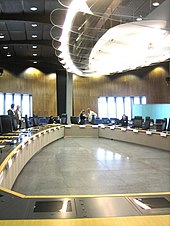College

The Commission is composed of a college of "Commissioners" of 27 members, including the President and vice-presidents. Even though each member is nominated on the basis of the suggestions made by the national governments, one per state, they do not represent their state in the Commission. In practice, however, they do occasionally press for their national interest. Once proposed, the President delegates portfolios among each of the members. The power of a Commissioner largely depends upon their portfolio, and can vary over time. For example, the Education Commissioner has been growing in importance, in line with the rise in the importance of education and culture in European policy-making. Another example is the Competition Commissioner, who holds a highly visible position with global reach. Before the Commission can assume office, the college as a whole must be approved by the Parliament. Commissioners are supported by their personal cabinet who give them political guidance, while the Civil Service (the DGs, see below) deal with technical preparation.
Appointmentedit
The President of the Commission is selected by consensus by the European Council and confirmed by the European Parliament or not. If not, the European Council shall propose another candidate within one month. The candidate has often been a leading national politician, but this is not a requirement. In 2009 (as with 2004), the Lisbon Treaty was not in force and Barroso was not "elected" by the Parliament, but rather nominated by the European Council; in any case, the centre-right parties of the EU pressured for a candidate from their own ranks. In the end, a centre-right candidate was chosen: José Manuel Barroso of the European People's Party.
There are further criteria influencing the choice of the candidate, including: which area of Europe the candidate comes from, favoured as Southern Europe in 2004; the candidate's political influence, credible yet not overpowering members; language, proficiency in French considered necessary by France; and degree of integration, their state being a member of both the eurozone and the Schengen Agreement. In 2004, this system produced a number of candidates and was thus criticised by some MEPs: following the drawn-out selection, the ALDE group leader Graham Watson described the procedure as a "Justus Lipsius carpet market" producing only the "lowest common denominator"; while Green-EFA co-leader Daniel Cohn-Bendit asked Barroso after his first speech "If you are the best candidate, why were you not the first?"
Following the selection of the President, and the appointment of the High Representative by the European Council, each Commissioner is nominated by their member state (except for those states who provided the President and High Representative) in consultation with the Commission President, although he holds no hard power to force a change in candidate. However the more capable the candidate is, the more likely the Commission President will assign them a powerful portfolio, the distribution of which is entirely at his discretion. The President's team is then subject to hearings at the European Parliament which will question them and then vote on their suitability as a whole. If members of the team are found to be too inappropriate, the President must then reshuffle the team or request a new candidate from the member state or risk the whole Commission being voted down. As Parliament cannot vote against individual Commissioners there is usually a compromise whereby the worst candidates are removed but minor objections are put aside so the Commission can take office. Once the team is approved by parliament, it is formally put into office by the European Council (TEU Article 17:7).
Following their appointment, the President appoints a number of Vice-Presidents (the High Representative is mandated to be one of them) from among the commissioners. For the most part, the position grants little extra power to Vice-Presidents, except the first Vice-President who stands in for the President when he or she is away.
Dismissaledit
The European Parliament can dissolve the Commission as a whole following a vote of no-confidence but only the President can request the resignation of an individual Commissioner. However, individual Commissioners, by request of the Council or Commission, can be compelled to retire on account of a breach of obligation(s) and if so ruled by the European Court of Justice (Art. 245 and 247, Treaty on the Functioning of the European Union).
Political stylesedit
The Barroso Commission took office in late 2004 after being delayed by objections from the Parliament, which forced a reshuffle. In 2007 the Commission increased from 25 to 27 members with the accession of Romania and Bulgaria who each appointed their own Commissioners. With the increasing size of the Commission, Barroso adopted a more presidential style of control over the college, which earned him some criticism.
However, under Barroso, the Commission began to lose ground to the larger member states as countries such as France, the UK and Germany sought to sideline its role. This has increased with the creation of the President of the European Council under the Treaty of Lisbon. There has also been a greater degree of politicisation within the Commission.
Comments
Post a Comment